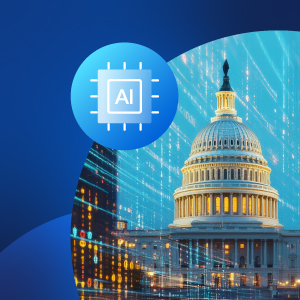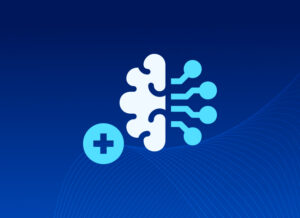To maintain its place as a leader in AI advancements, and to comply with the latest White House guidance, Government agencies must harness AI capabilities, such as secure cloud computing platforms, high-performance data processing systems and scalable machine learning frameworks, for critical functions such as cybersecurity, predictive analytics and economic competitiveness. As with any new technology, AI requires updated infrastructure to power these advanced capabilities.
The Capabilities of AI Infrastructure
AI infrastructure refers to the hardware and software needed to create and deploy AI-powered applications and solutions. It enables both AI, the technology that simulates the way people think, and machine learning (ML), a focus area of AI that utilizes data and algorithms to imitate the way humans learn, increasing the accuracy of its results the more data you input. AI infrastructure enables users to create and deploy AI and ML apps, such as chatbots, facial and speech recognition and computer vision.
Building the infrastructure for AI requires data storage and processing, compute resources, ML frameworks and MLOps platforms to acquire the processing capabilities needed for AI, and also to train ML models.
AI Infrastructure Deep Dive
Below are the six pillars that define a strong AI foundation, each continuously evolving to keep pace with the next generation of AI capabilities.

Specialized Compute
In 2025, AI solutions rely on more than GPUs, they use a mix of processors designed for different types of AI tasks. This makes it faster and more cost-effective to train, update and run today’s complex models. As AI systems are becoming more advanced, many models are becoming larger and require HPC solutions. On the other hand, smaller models can run on cloud-based architecture for lower compute needs.
Data Preparation
The success of an AI solution can tie back to how well the data is prepared before it’s used. Modern AI infrastructure now includes built-in tools to clean, label and organize data at scale, sometimes using AI itself to automate the work. This ensures models are trained on accurate, relevant information, while also tagging and tracking data to meet security, compliance and transparency requirements.
Data Storage
Because today’s AI solutions are becoming more and more advanced, additional data is required to train the models. AI now depends on lightning-fast data storage that can easily grow alongside datasets. New tools also make it possible to keep sensitive data in specific locations or environments, meeting strict privacy and Government requirements without slowing down AI workflows.
Networking
As AI models get bigger, the speed of moving information between systems is critical. New high-speed networks reduce delays so AI can process and deliver results in near real-time, even across large environments.
Software & Orchestration
Managing AI today requires controlling the entire process from development to deployment. Modern platforms help teams easily update models, track their history and ensure they run efficiently whether in the cloud, on-premises, or in secure Government networks.
Security & Governance
AI infrastructure in 2025 is built with security at its core. It goes through rigorous testing to ensure it meets Government compliance standards and protects sensitive information. It is important to choose solutions from providers that continuously monitor their models, ensuring they’re safe, reliable and ready to be audited at any time.
All these AI Infrastructure features will be utilized by Government agencies to enable AI solutions that improve workflows and maintain global competitiveness.
AI Infrastructure: A National Priority
Executive Order 14141 names AI infrastructure, including data centers and compute clusters that are powered by clean energy, as a national priority to upholding U.S. leadership, national security and competition.
The order encourages Government agencies to secure supply chains, integrate clean energy and collaborate with the private sector. It also directs Federal agencies to make Federal lands and sites available for clean power generation and gigawatt-scale AI data centers
In alignment with the Executive Order, the Department of Energy (DOE) has released a Request for Information (RFI) to use its territories to build AI infrastructure datacenters, citing that they would enable AI training and inference, scientific research and other essential services.
Most recently, the AI Action Plan outlines recommended policy actions regarding building AI infrastructure such as data centers, semiconductor manufacturing facilities and energy infrastructure. The goal of the AI Action Plan is to streamline AI adoption and, in turn, speed up and scale the development of AI infrastructure on the federal level. National Security, AI incident response, cybersecurity and secure-by-design systems are highlighted as vital pillars of the AI Action Plan’s infrastructure guidance. By sharing specific steps to achieve safe and secure AI infrastructure, such as identifying available federal land, training our workforce, building data centers and keeping security at the backbone, the AI Action Plan outlines clear next steps that agencies need to take in order to push AI adoption forward.
In an increasingly technology-driven landscape, AI infrastructure allows Government agencies to modernize their operations and deliver more efficient, responsive services. Strategic investment in AI infrastructure enables agencies to enhance decision-making processes, reduce operational costs, protect national security interest and fulfill their core mandate of serving citizens. Once this foundation is in place, agencies can begin to build and deploy solutions that directly support their missions. The next blog in our series will explore how this infrastructure enables Generative AI and its potential for transforming Government workflows.
Carahsoft’s ecosystem of hardware and software vendors are equipped to connect agencies with the latest technology for AI, including the infrastructure needed to run it. To learn more about AI infrastructure solutions that are tailored for the Public Sector, visit Carahsoft’s Page on AI Solutions.








